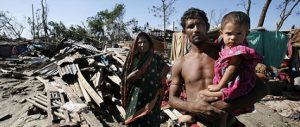Preparing for and responding to the impacts of climate change – a process termed “adaptation” – is now essential. Yet it also remains crucial to reduce greenhouse-gas emissions: to rely on adaptation alone would lead to a level of climate change to which we can no longer adapt, or only at very high social, economic and environmental costs.
The Bali Action Plan, agreed on by climate negotiators in 2007 at the UN climate conference in Bali, gives equal weight to adaptation and emission reduction, and launched a process “to reach an agreed outcome and adopt a decision” at the climate conference in Copenhagen in 2009. In the event, there was no agreed outcome. Instead there was the Copenhagen Accord, a non-binding political declaration that has considerably less substance on adaptation than the Bali Action Plan.
The Bali Action Plan signals that there should be finance available to enable developing countries to adapt and develop sustainably. The Copenhagen Accord does set targets for financial support, but it skirts this crucial link between adaptation and development, and the issue is far from resolved.
Development decision-making increasingly takes climate change into account. For example, in an area likely to face more intense rainfall, water managers might fit a drainage system with bigger pipes when replacing old ones. Or, where drought is predicted to increase, farmers might be advised to choose crops better suited to dry conditions.
However, adaptation is not only about technological solutions. To fully “mainstream” (integrate) adaptation into development, measures are needed that tackle the underlying factors creating vulnerability to climate change. A more robust strategy would involve coordinated measures including education, crop diversification, pest management and rainwater harvesting. Furthermore, a poor rural household is more likely to use these options if it has a literate family member, access to capital through local financial institutions and functioning social networks, and if it can hold policymakers accountable.
From this perspective, mainstreaming adaptation into development makes sense because both contribute to human security. But from a climate-policy perspective, mainstreaming creates a dilemma, because financing for adaptation and for development is managed separately.
An obvious argument for mainstreaming is that it is more efficient than adaptation measures designed, implemented and managed separately from development planning and decision-making. However, developing countries are concerned that mainstreaming is a ploy by rich countries to dodge their commitment to provide “new and additional” funding for adaptation. The suspicion is that, by seeking “synergies” between adaptation and development, rich countries will absorb the cost into their aid budgets. These concerns are fuelled by the fact that the money currently available for adaptation is only a fraction of the estimated investment needs in developing countries. Moreover, only a few rich countries have achieved their repeated commitment to provide Official Development Assistance (ODA) equal to 0.7% of their gross national income.
A second, related concern is that mainstreaming could divert any new and additional funds for adaptation into more general development activities, which would make it more difficult to evaluate the benefits of the funds in terms of climate change. And a third worry is that if adaptation finance were combined with or part of ODA, it would allow rich countries to impose conditions on the use of adaptation finance, which should be a country-driven process.
In pre-Copenhagen talks, developing countries opposed mainstreaming and called for “stand-alone” adaptation activities, because these would allow for the measurable, reportable and verifiable use of new and additional funding, as stipulated in the Bali Action Plan.
The Copenhagen Accord does not address the dilemma of mainstreamed versus stand-alone adaptation. The accord does recognise that much more money is needed to support mitigation and adaptation – US$100 billion (664 billion yuan) a year by 2020 to address the needs of developing countries – but its non-binding status, uncertainty over where the funds will come from and a history of unmet pledges all cast doubt over whether the money will materialise, and, if it does, whether it will be new and additional.
To tackle this dilemma, and the concerns of developing countries, developed countries need to take a range of actions. First, they need to deal with two key questions:
· Should adaptation finance be used to support stand-alone project activities or should it contribute to mainstreaming adaptation into development?
· Should adaptation finance follow the polluter-pays principle or is adaptation an additional focus of ODA?
As for the first question, the choice should be an outcome of a country-driven national planning process. National adaptation planning in developing countries needs to be supported under the United Nations Framework Convention on Climate Change (UNFCCC), and developed countries must provide follow-up support to implement these plans. As for the second, whether ODA or new and additional funding is most appropriate depends on the nature of the adaptation activity.
Developed countries should also clarify how ODA, the Adaptation Fund (an existing institution under the Kyoto Protocol), the new Green Climate Fund (established by the Copenhagen Accord), private finance and other bilateral and multilateral funds for adaptation can complement one another. They also need to provide a credible approach to generating adequate, new and additional money. Levies on carbon-market transactions and auctions of emission permits are two mechanisms for generating new and additional funds broadly consistent with the polluter pays principle, and the use of such mechanisms can be expanded. Developed countries must also meet their commitment on ODA.
It is crucial that developed countries rebuild trust. Unless rich nations can address developing countries’ concerns over equity, fairness and the neutrality of institutions, any future agreement on climate finance will be hobbled.
This article is based on Klein, R.J.T., 2010: “Mainstreaming climate adaptation into development: a policy dilemma”, in: Climate Governance and Development, A. Ansohn and B. Pleskovic (eds), World Bank, Washington, DC, USA, pp. 35–52.
Richard JT Klein is a senior research fellow at the Stockholm Environment Institute and an adjunct professor at the Centre for Climate Science and Policy Research of Linköping University. He is the founder and editor in chief of the academic journal Climate and Development and has been an IPCC author since 1994.
Homepage image by Abdul Majeed Goraya_IRIN


